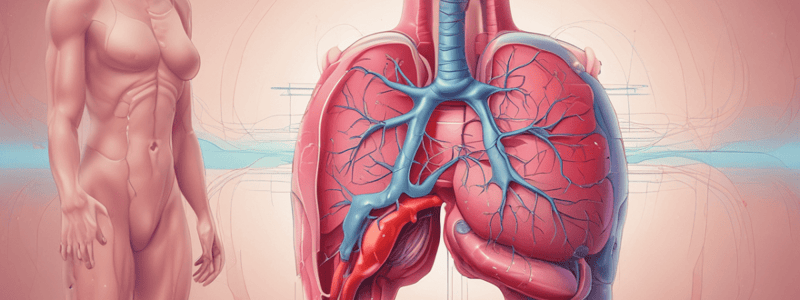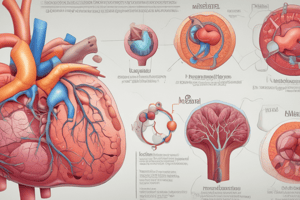Podcast
Questions and Answers
What is the unique feature of the circulation of blood through the intestines and liver in human anatomy?
What is the unique feature of the circulation of blood through the intestines and liver in human anatomy?
- Blood from the liver flows directly into the intestines
- Blood from the hepatic capillary system flows into the intestinal capillary system
- Blood from the heart flows directly into the liver
- Blood from the intestinal capillary system flows into the hepatic capillary system (correct)
Which of the following is NOT a function of the liver?
Which of the following is NOT a function of the liver?
- Synthesis of albumin
- Catabolism of hormones
- Production of bile acids (correct)
- Storage of glycogen
What is the term for the reabsorption of hormones and other serum proteins by the liver?
What is the term for the reabsorption of hormones and other serum proteins by the liver?
- Enterohepatic circulation
- Gluconeogenesis
- Glycogenolysis
- Catabolism (correct)
Which of the following is a common consequence of liver disease?
Which of the following is a common consequence of liver disease?
What is the final endpoint of many liver diseases?
What is the final endpoint of many liver diseases?
Which of the following is a common complication of cirrhosis?
Which of the following is a common complication of cirrhosis?
What is the term for the inflammation of the liver?
What is the term for the inflammation of the liver?
Which of the following is a characteristic of steatohepatitis?
Which of the following is a characteristic of steatohepatitis?
What is the term for the degeneration of liver cells, characterized by swelling and fatty infiltration?
What is the term for the degeneration of liver cells, characterized by swelling and fatty infiltration?
Which of the following is a common metabolic consequence of liver disease?
Which of the following is a common metabolic consequence of liver disease?
What is the most common type of viral hepatitis in the world?
What is the most common type of viral hepatitis in the world?
What is the primary mode of transmission of HAV?
What is the primary mode of transmission of HAV?
What is the most common cause of chronic liver disease?
What is the most common cause of chronic liver disease?
What is the approximate number of new cases of HCV per year in the US?
What is the approximate number of new cases of HCV per year in the US?
What is the main reason for the difficulty in developing a vaccine for HCV?
What is the main reason for the difficulty in developing a vaccine for HCV?
What is the primary mode of transmission of HDV?
What is the primary mode of transmission of HDV?
What is the characteristic of autoimmune hepatitis?
What is the characteristic of autoimmune hepatitis?
What is the most common cause of liver abscess in industrialized nations?
What is the most common cause of liver abscess in industrialized nations?
What is the approximate percentage of HBV patients who develop chronic viral hepatitis?
What is the approximate percentage of HBV patients who develop chronic viral hepatitis?
What is the characteristic of fulminant hepatitis or hepatic failure?
What is the characteristic of fulminant hepatitis or hepatic failure?
What is the primary function of albumin in maintaining body fluid balance?
What is the primary function of albumin in maintaining body fluid balance?
Which of the following liver function tests is most specific to liver damage?
Which of the following liver function tests is most specific to liver damage?
What is the characteristic feature of cirrhosis?
What is the characteristic feature of cirrhosis?
Which of the following viruses is associated with acute and mild hepatitis?
Which of the following viruses is associated with acute and mild hepatitis?
What is the consequence of obstruction of the extrahepatic bile ducts?
What is the consequence of obstruction of the extrahepatic bile ducts?
What is the primary cause of ascites in liver disease?
What is the primary cause of ascites in liver disease?
What is the characteristic laboratory finding in hepatic failure?
What is the characteristic laboratory finding in hepatic failure?
What is the significance of gamma-glutamyl transferase (GGT) in liver function tests?
What is the significance of gamma-glutamyl transferase (GGT) in liver function tests?
What is the consequence of repeated episodes of liver cell necrosis and regeneration?
What is the consequence of repeated episodes of liver cell necrosis and regeneration?
What is the primary mechanism of liver damage in autoimmune hepatitis?
What is the primary mechanism of liver damage in autoimmune hepatitis?
What is the minimum amount of daily alcohol consumption required to produce cirrhosis in approximately 10-16 years?
What is the minimum amount of daily alcohol consumption required to produce cirrhosis in approximately 10-16 years?
What is the term for the accumulation of fat in liver cells, often seen as the first sign of alcohol liver injury?
What is the term for the accumulation of fat in liver cells, often seen as the first sign of alcohol liver injury?
What is the primary mechanism of hemochromatosis?
What is the primary mechanism of hemochromatosis?
What is the term for the autoimmune disease characterized by inflammatory destruction of intrahepatic bile ducts?
What is the term for the autoimmune disease characterized by inflammatory destruction of intrahepatic bile ducts?
What is the most common neoplasm in the liver?
What is the most common neoplasm in the liver?
What is the term for the obstruction of the hepatic vein as it flows out of the liver?
What is the term for the obstruction of the hepatic vein as it flows out of the liver?
What is the term for the presence of gallstones in the gallbladder or biliary tree?
What is the term for the presence of gallstones in the gallbladder or biliary tree?
What is the most common major complication of gallstones?
What is the most common major complication of gallstones?
What is the term for the type of gallstones that are composed of bilirubin and calcium salts?
What is the term for the type of gallstones that are composed of bilirubin and calcium salts?
What is the term for the autoimmune disease characterized by the accumulation of copper in the brain and liver?
What is the term for the autoimmune disease characterized by the accumulation of copper in the brain and liver?
Flashcards are hidden until you start studying
Study Notes
Liver Anatomy and Function
- Unique circulation of blood through the intestines and liver (enterohepatic circulation)
- Liver has a functional reserve that must suffer a large loss before becoming symptomatic
- Liver function tests (LFTs) measure enzymes (e.g., LDH, AST, ALT, ALKP, bilirubin) to assess liver function
Liver Diseases
- Chronic liver disease can lead to toxic accumulations of metabolic waste (e.g., ammonia, bilirubin), bleeding, edema, and failure to absorb intestinal fat
- Viral hepatitis (HAV, HBV, HCV, HDV, HEV) can cause acute and chronic hepatitis, cirrhosis, and liver cancer
- Autoimmune hepatitis is a chronic liver disease not associated with viral infection
- Liver abscess is a focal collection of necrotic tissue, inflammatory debris, and fluid
Hepatitis A (HAV)
- Primarily fecal-oral transmission
- Benign and self-limiting
- Incubation period is about 2-6 weeks
- Most common type of hepatitis worldwide
- Fatalities are rare
- No carrier state
- Vaccine is available
Hepatitis B (HBV)
- Detector by presence of HBsAg
- Viremia may last for many weeks
- 1st antibody to appear is anti-HBc
- Beginning of recovery marked by appearance of anti-HBs, which confers immunity
- Transmitted through blood, saliva, semen, and vertically from mother to child
- Vaccine is available
Hepatitis C (HCV)
- Major cause of chronic liver disease
- Incubation period varies from a few weeks to 6 months
- About 40,000 new cases per year
- About 2% have antibodies indicating previous infection
- Transmission is primarily through IV drug abuse, sexual contact, and infected healthcare workers
- Mutating RNA virus, making vaccine development difficult
Hepatitis D (HDV)
- Co-infects with HBV
- Mostly in IV drug abusers and hemophiliacs
- Delta virus
Hepatitis E (HEV)
- Rare in the US but most common form of epidemic hepatitis in India
- Transmitted like HAV
- Mild and self-limiting
Pathology of Hepatitis
- Carrier state: liver biopsy normal, usually
- Acute hepatitis: hydropic degeneration, chronic inflammation, necrosis of individual cells
- Fulminant hepatitis or hepatic failure: extensive necrosis
- Chronic hepatitis: more severe damage, disorganized, intense inflammatory reaction, more extensive necrosis, scar tissue
Cirrhosis
- Final, common endstage for various chronic liver diseases
- Patterned fibrosis characterized by interconnecting bands of scar tissue, dividing the liver into small nodules separated by dense fibrous tissue
- Progressive, irreversible, and incurable, usually due to alcoholic liver disease, chronic viral hepatitis, or chronic disease of the biliary tree
Alcoholic Liver Disease
- Amount necessary to produce cirrhosis: about 200gms/day for 10-16 years
- Sequence of damage: fatty liver, alcoholic hepatitis, cirrhosis, and steatohepatitis/alcoholic hepatitis
- Severe damage if: abnormal clotting tests, low albumin, signs of hepatic failure
Other Liver Diseases
- Hemochromatosis: toxic accumulation of iron in cells, especially the liver, heart, and pancreas
- Wilson disease: autosomal recessive disorder, toxic accumulation of copper mainly in the brain and liver
- Primary biliary cirrhosis: autoimmune disease, inflammatory destruction of intrahepatic bile ducts
- Hepatocellular carcinoma: usually related to HBV and HCV, high levels of alpha-fetoprotein, grim prognosis
- Metastatic carcinoma: most common neoplasm in the liver, usually from colon, lung, or breast
Studying That Suits You
Use AI to generate personalized quizzes and flashcards to suit your learning preferences.




